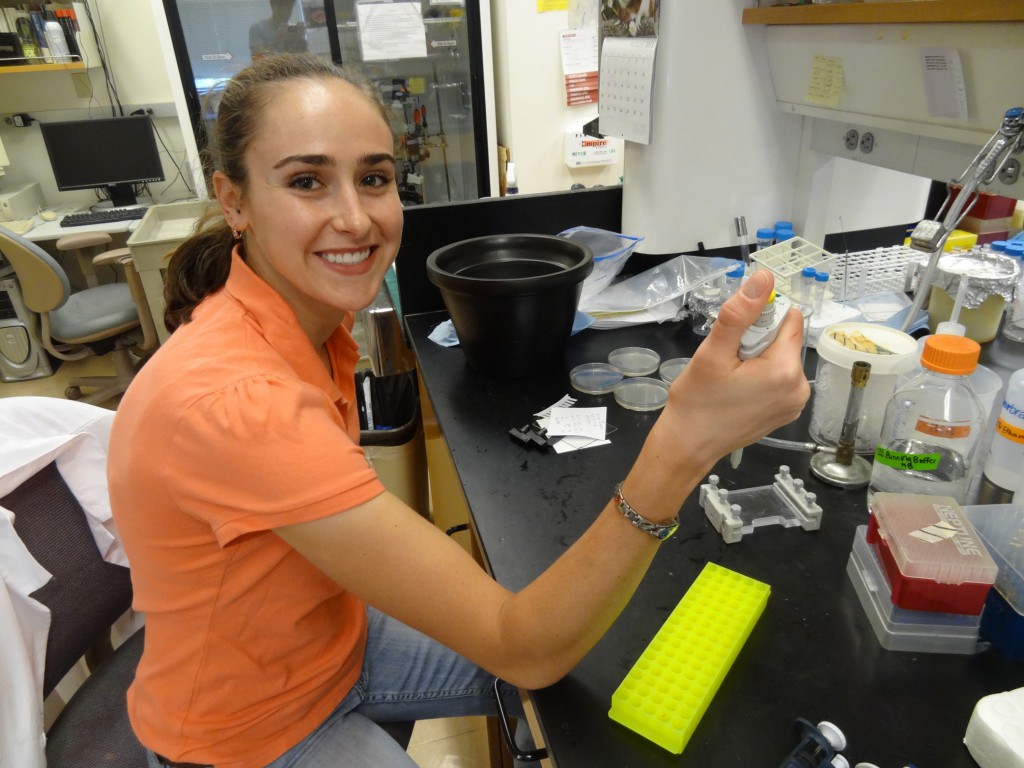E-mail: mkbrinkmeyer@ucdavis.edu
Project: Investigation of the function of the N-terminal domain of BRCA2 and of the biological regulation of the protein-protein interactions that occur within this region.
The high prevalence of breast and ovarian cancers caused by mutations in the tumor suppressor BRCA1 and BRCA2 genes creates a real need to study the structural and functional properties of these proteins. The majority of information on BRCA2 is for the C-terminal DSS1/DNA binding domain (DBD) and the central 8 BRC repeats, since these two regions have been shown to interact with RAD51 in mediating homologous recombination (HR). In contrast, the functional significance of the N-terminal domain of BRCA2 and the regulation of protein-protein interactions that occur within this region remain to be elucidated and thus is the focus of my project.
Education
2006-2012Ph.D., Biological Chemistry, University of California Davis, Davis, CA
2002-2006 B.S., Biological Chemistry, Saint Mary’s College of California, Moraga, CA
Research Experience
2013-present Postdoctoral Research, University of California, Davis, CA
- Secured a NIH NRSA T32 Training grant to support a two year stipend.
- Experienced in bacterial, insect cell, and fungal recombinant expression.
- Employed in vitro assays to assess the biological function of the N-terminal domain of the BRCA2 protein.
2006-2012 Doctoral Research, University of California Davis, Davis, CA
- Obtained experience in bacterial and insect cell recombinant expression as well as protein purification using both affinity column chromatography and FPLC systems.
- Employed in vitro kinetic and binding assays, developed a cell-based repair assay, and performed pull down assays to biochemically characterize a handful of MUTYH variant enzymes associated with colorectal cancer.
2005-2006 Research Assistant, Chemistry & Materials Science Dept., LLNL, Livermore, CA
- Synthesized 3-trifluoromethyl-3-m-aminophenyl diazirine, a cross-linker molecule to be the basis of a polymer-coated microcantilever biosensor for chemical vapor detection, as described in Issue 5, Volume 133 of Analyst in 2008. Intern under analytical chemist, Bradley Hart.
- Designed and tested a method to extract and detect domoic acid (DA), a naturally occurring neurotoxic amino acid, in common food matrices using HPLC. Intern under analytical chemist, Bradley Hart.
Honors and Awards
2013-2015 NIH Oncogenic Signals and Chromosome Biology T32 Training Grant
2012 Travel Award, American Chemical Society Division of Biological Chemistry
2012 Graduate Student Travel Award, University of California, Davis
2006-2012 Dean’s Honor’s List all quarters at the University of Davis, CA
2006-2008 Bradford Borge Graduate Fellowship, UC Davis
2002-2006 Dean’s Honor’s List all semesters at Saint Mary’s College of California
Publications
Kundu, S., M.K. Brinkmeyer, and S.S. David. Adenine removal activity and bacterial complementation with the human MutY homologue (MUTYH) and Y165C, G382D, P391L, and Q324R variants associated with colorectal cancer. DNA Repair. 8.12, 1400-1410 (2009). (PMCID: 19836313)
Kundu, S., M.K. Brinkmeyer, R.A. Eigenheer, and S.S. David. Ser524 is a phosphorylation site in MUTYH and Ser524 mutations alter 8-oxoguanine (OG):A mismatch recognition. DNA Repair. 9.10, 1026-1037 (2010). (PMCID: 20724227)
Brinkmeyer, M.K., M.M.Pope, and S.S. David. Catalytic contributions of key residues in the adenine DNA glycosylase MutY revealed by pH dependent kinetics and cellular repair assays. Chemistry and Biology. 19.2, 276-286 (2012). (PMCID: 22365610)
Raetz, A.G.,Y. Xie, S. Kundu, M.K. Brinkmeyer, C. Chang, and S.S. David. Cancer-associated variants and a common polymorphism of MUTYH exhibit reduced repair of oxidative DNA damage using a GFP-based assay in mammalian cells. Carcinogenesis. 33.11, 2301-9 (2012). (PMCID:22926731)
Engstrom, L.M., M.K. Brinkmeyer, Y. Ha, A.G. Raetz, B. Hedman, K. Hodgson, E.I. Solomon, and S.S. David. A Zinc Linchpin Motif in the MUTYH Glycosylase Interdomain Connector Is Required for Efficient Repair of DNA Damage. J. Am. Chem. Soc. 136.22, 7829-7832 (2014).
